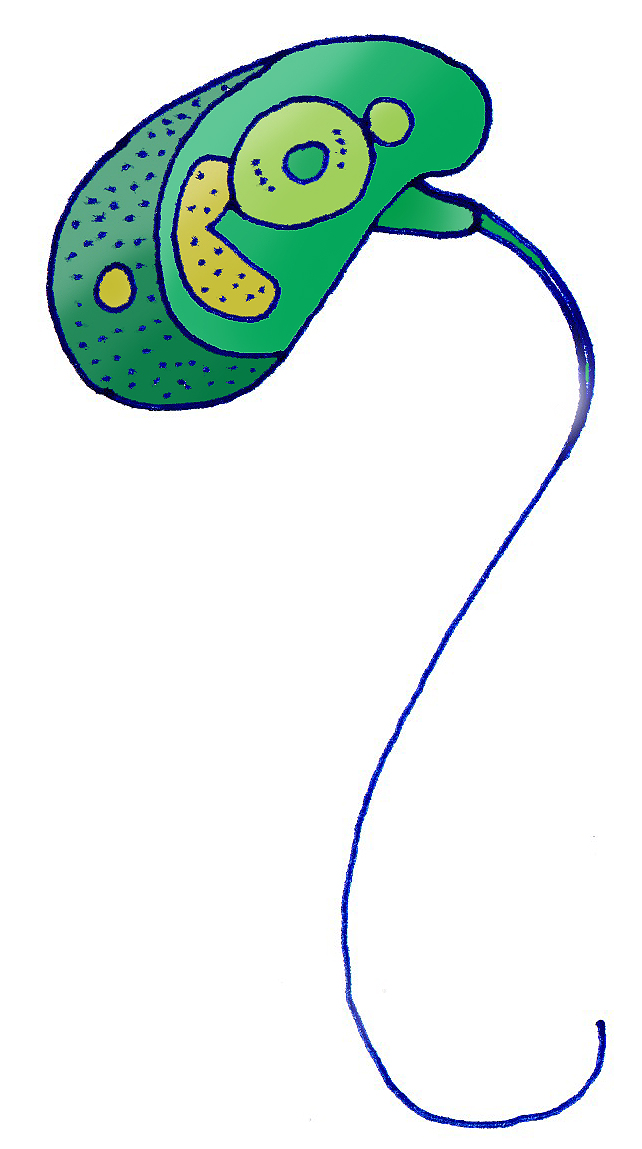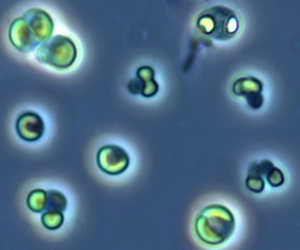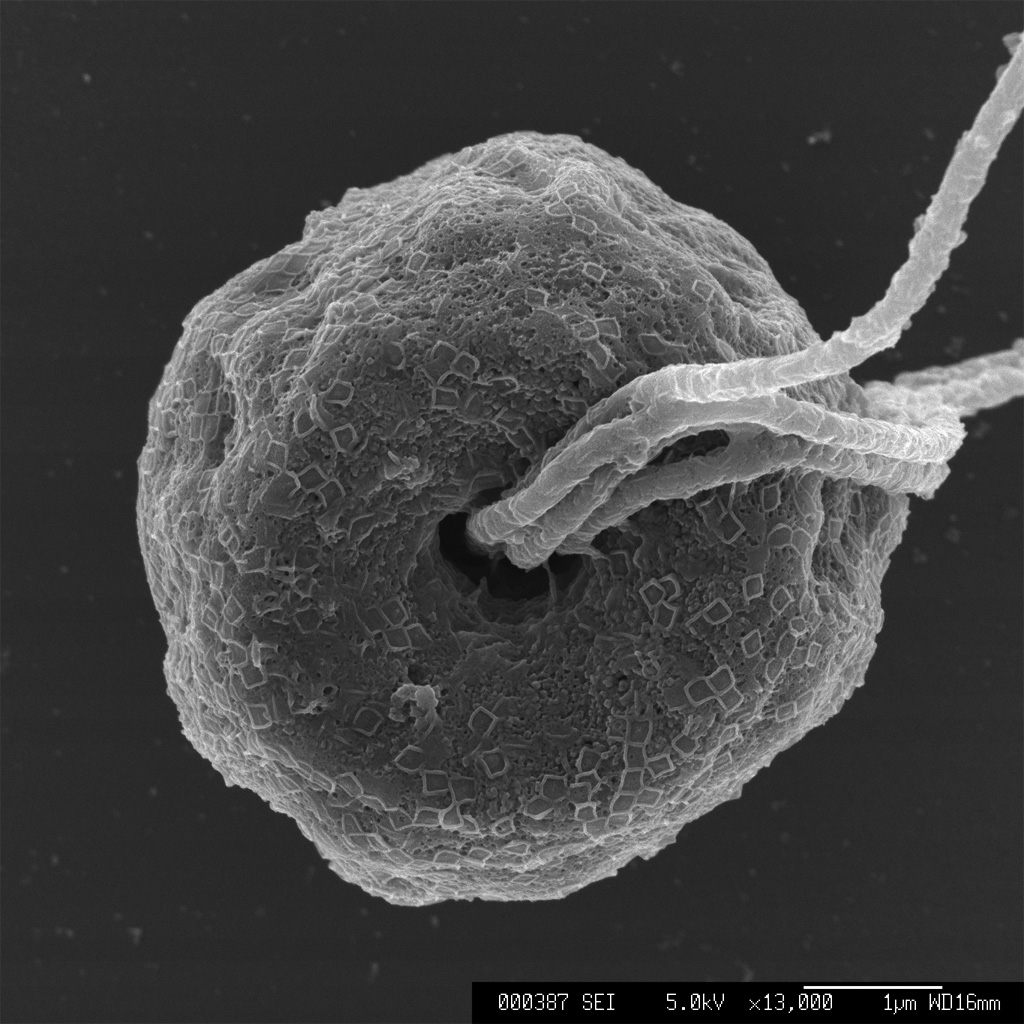|
Prasinophytes
The prasinophytes are a group of unicellular green algae. Prasinophytes mainly include marine planktonic species, as well as some freshwater representatives.Sym, S. D. and Pienaar, R. N. 1993. The class Prasinophyceae. In Round, F. E. and Chapman, D. J. (eds) ''Progress in Phycological Research'', Vol. 9. Biopress Ltd., Bristol, pp. 281-376. The prasinophytes are morphologically diverse, including flagellates with one to eight flagella and non-motile (coccoid) unicells. The cells of many species are covered with organic body scales; others are naked. Well studied genera include ''Ostreococcus'', considered to be the smallest (ca. 0.95 μm) free-living eukaryote, and ''Micromonas'', both of which are found in marine waters worldwide. Prasinophytes have simple cellular structures, containing a single chloroplast and a single mitochondrion. The genomes are relatively small compared to other eukaryotes (about 12 Mbp for ''Ostreococcus'' and 21 Mbp for ''Micromonas''). At least on ... [...More Info...] [...Related Items...] OR: [Wikipedia] [Google] [Baidu] |
Prasinophyceae
The prasinophytes are a group of unicellular green algae. Prasinophytes mainly include marine planktonic species, as well as some freshwater representatives.Sym, S. D. and Pienaar, R. N. 1993. The class Prasinophyceae. In Round, F. E. and Chapman, D. J. (eds) ''Progress in Phycological Research'', Vol. 9. Biopress Ltd., Bristol, pp. 281-376. The prasinophytes are morphologically diverse, including flagellates with one to eight flagella and non-motile (coccoid) unicells. The cells of many species are covered with organic body scales; others are naked. Well studied genera include ''Ostreococcus'', considered to be the smallest (ca. 0.95 μm) free-living eukaryote, and ''Micromonas'', both of which are found in marine waters worldwide. Prasinophytes have simple cellular structures, containing a single chloroplast and a single mitochondrion. The genomes are relatively small compared to other eukaryotes (about 12 Mbp for ''Ostreococcus'' and 21 Mbp for ''Micromonas''). At least one spe ... [...More Info...] [...Related Items...] OR: [Wikipedia] [Google] [Baidu] |
Chloropicophyceae
Chloropicophyceae is a class of green algae in the division Chlorophyta that, along with Picocystophyceae, coincides with the traditional "prasinophyte clade VII". Description Members of this class are coccoid green cells, with a diameter of 1.5–4 µm, found in marine waters, with one nucleus, one mitochondrion, and one chloroplast surrounded by two membranes, containing starch grain; their single chloroplast has chlorophylls '' a'' and '' b''; they lack pyrenoid and flagella; and they have a layered cell wall. Their sexual reproduction is unknown. Taxonomy In total, this class contains eight newly described species, belonging to two genera. The taxonomy goes as follows : *Division Chlorophyta Reichenbach 1834 ** Class Chloropicophyceae Lopes dos Santos & Eikrem 2017 *** Order Chloropicales Lopes dos Santos & Eikrem 2017 **** Family Chloropicaceae Lopes dos Santos & Eikrem 2017 ***** Genus '' Chloropicon'' Lopes dos Santos & Eikrem 2017 ****** ''Chloropicon sieburthii'' L ... [...More Info...] [...Related Items...] OR: [Wikipedia] [Google] [Baidu] |
Picocystophyceae
''Picocystis'' is a monotypic genus of green algae, the sole species is ''Picocystis salinarum''. It is placed within its own class, Picocystophyceae in the division Chlorophyta. Structure ''Picocystis salinarum'' cells under normal conditions have a spherical or oval shape. Their size ranges from 2 to 3μm (micrometer, 10^-6) in diameter. Under conditions of nutrient depletion they appear to form a trillobe shape. This trillobe shape gives it the nickname Mickey Mouse, due to its appearance to the famous character's head. The general appearance resembles that of a standard green algae. The pigments are composed mainly from chlorophyll a and b and the carotenoids violaxanthin, alloxanthin, monadoxanthin, neoxanthin, lutein, diatoxanthin and zeaxanthin. The cell wall is mainly composed of polymers of the monosaccharide arabinose, polyarabinose. Habitat The species have been found in saline or hypersaline alkaline In chemistry, an alkali (; from ar, القلوي, ... [...More Info...] [...Related Items...] OR: [Wikipedia] [Google] [Baidu] |
Micrometre
The micrometre ( international spelling as used by the International Bureau of Weights and Measures; SI symbol: μm) or micrometer (American spelling), also commonly known as a micron, is a unit of length in the International System of Units (SI) equalling (SI standard prefix "micro-" = ); that is, one millionth of a metre (or one thousandth of a millimetre, , or about ). The nearest smaller common SI unit is the nanometre, equivalent to one thousandth of a micrometre, one millionth of a millimetre or one billionth of a metre (). The micrometre is a common unit of measurement for wavelengths of infrared radiation as well as sizes of biological cells and bacteria, and for grading wool by the diameter of the fibres. The width of a single human hair ranges from approximately 20 to . The longest human chromosome, chromosome 1, is approximately in length. Examples Between 1 μm and 10 μm: * 1–10 μm – length of a typical bacterium * 3–8 μm – width of ... [...More Info...] [...Related Items...] OR: [Wikipedia] [Google] [Baidu] |
Eukaryote
Eukaryotes () are organisms whose cells have a nucleus. All animals, plants, fungi, and many unicellular organisms, are Eukaryotes. They belong to the group of organisms Eukaryota or Eukarya, which is one of the three domains of life. Bacteria and Archaea (both prokaryotes) make up the other two domains. The eukaryotes are usually now regarded as having emerged in the Archaea or as a sister of the Asgard archaea. This implies that there are only two domains of life, Bacteria and Archaea, with eukaryotes incorporated among archaea. Eukaryotes represent a small minority of the number of organisms, but, due to their generally much larger size, their collective global biomass is estimated to be about equal to that of prokaryotes. Eukaryotes emerged approximately 2.3–1.8 billion years ago, during the Proterozoic eon, likely as flagellated phagotrophs. Their name comes from the Greek εὖ (''eu'', "well" or "good") and κάρυον (''karyon'', "nut" or "kernel"). Euka ... [...More Info...] [...Related Items...] OR: [Wikipedia] [Google] [Baidu] |
Micromonas
''Micromonas'' is a genus of green algae in the family ''Mamiellaceae''. Before the characterization in 2016 of a second species, ''Micromonas commoda'', ''Micromonas pusilla'' was considered to be the only species in the genus, which led to a disproportionate amount of research discussing a single species within the genus. It is suggested to be the dominant photosynthetic picoeukaryote in some marine ecosystems. Unlike many marine algae, it is distributed widely in both warm and cold waters.Genomes of Two Strains of Micromonas Algae Show Surprising Diversity , ''Alternative Energy Newswire'', April 10, 2009 It is a strong swimmer and exhibits a phototaxic response. ''Micromonas pusilla'' is divided into 3 to 5 different |
Chloroplast
A chloroplast () is a type of membrane-bound organelle known as a plastid that conducts photosynthesis mostly in plant and algal cells. The photosynthetic pigment chlorophyll captures the energy from sunlight, converts it, and stores it in the energy-storage molecules ATP and NADPH while freeing oxygen from water in the cells. The ATP and NADPH is then used to make organic molecules from carbon dioxide in a process known as the Calvin cycle. Chloroplasts carry out a number of other functions, including fatty acid synthesis, amino acid synthesis, and the immune response in plants. The number of chloroplasts per cell varies from one, in unicellular algae, up to 100 in plants like ''Arabidopsis'' and wheat. A chloroplast is characterized by its two membranes and a high concentration of chlorophyll. Other plastid types, such as the leucoplast and the chromoplast, contain little chlorophyll and do not carry out photosynthesis. Chloroplasts are highly dynamic—they circulat ... [...More Info...] [...Related Items...] OR: [Wikipedia] [Google] [Baidu] |
Mitochondrion
A mitochondrion (; ) is an organelle found in the cells of most Eukaryotes, such as animals, plants and fungi. Mitochondria have a double membrane structure and use aerobic respiration to generate adenosine triphosphate (ATP), which is used throughout the cell as a source of chemical energy. They were discovered by Albert von Kölliker in 1857 in the voluntary muscles of insects. The term ''mitochondrion'' was coined by Carl Benda in 1898. The mitochondrion is popularly nicknamed the "powerhouse of the cell", a phrase coined by Philip Siekevitz in a 1957 article of the same name. Some cells in some multicellular organisms lack mitochondria (for example, mature mammalian red blood cells). A large number of unicellular organisms, such as microsporidia, parabasalids and diplomonads, have reduced or transformed their mitochondria into other structures. One eukaryote, ''Monocercomonoides'', is known to have completely lost its mitochondria, and one multicellular organism, '' ... [...More Info...] [...Related Items...] OR: [Wikipedia] [Google] [Baidu] |
Pyramimonas
''Pyramimonas'' is a genus of green algae in the order Pyramimonadales.See the NCBI The National Center for Biotechnology Information (NCBI) is part of the United States National Library of Medicine (NLM), a branch of the National Institutes of Health (NIH). It is approved and funded by the government of the United States. The ...br>webpage on Pyramimonas Data extracted from the References Chlorophyta genera Pyramimonadophyceae {{green algae-stub ... [...More Info...] [...Related Items...] OR: [Wikipedia] [Google] [Baidu] |
Genome
In the fields of molecular biology and genetics, a genome is all the genetic information of an organism. It consists of nucleotide sequences of DNA (or RNA in RNA viruses). The nuclear genome includes protein-coding genes and non-coding genes, other functional regions of the genome such as regulatory sequences (see non-coding DNA), and often a substantial fraction of 'junk' DNA with no evident function. Almost all eukaryotes have mitochondria and a small mitochondrial genome. Algae and plants also contain chloroplasts with a chloroplast genome. The study of the genome is called genomics. The genomes of many organisms have been sequenced and various regions have been annotated. The International Human Genome Project reported the sequence of the genome for ''Homo sapiens'' in 200The Human Genome Project although the initial "finished" sequence was missing 8% of the genome consisting mostly of repetitive sequences. With advancements in technology that could handle sequenci ... [...More Info...] [...Related Items...] OR: [Wikipedia] [Google] [Baidu] |
Flagellate
A flagellate is a cell or organism with one or more whip-like appendages called flagella. The word ''flagellate'' also describes a particular construction (or level of organization) characteristic of many prokaryotes and eukaryotes and their means of motion. The term presently does not imply any specific relationship or classification of the organisms that possess flagella. However, the term "flagellate" is included in other terms (such as "dinoflagellate" and "choanoflagellata") which are more formally characterized. Form and behavior Flagella in eukaryotes are supported by microtubules in a characteristic arrangement, with nine fused pairs surrounding two central singlets. These arise from a basal body. In some flagellates, flagella direct food into a cytostome or mouth, where food is ingested. Flagella often support hairs, called mastigonemes, or contain rods. Their ultrastructure plays an important role in classifying eukaryotes. Among protoctists and microscopic anima ... [...More Info...] [...Related Items...] OR: [Wikipedia] [Google] [Baidu] |
Pyramimonas Gelidicola
''Pyramimonas'' is a genus of green algae in the order Pyramimonadales.See the NCBI The National Center for Biotechnology Information (NCBI) is part of the United States National Library of Medicine (NLM), a branch of the National Institutes of Health (NIH). It is approved and funded by the government of the United States. The ...br>webpage on Pyramimonas Data extracted from the References Chlorophyta genera Pyramimonadophyceae {{green algae-stub ... [...More Info...] [...Related Items...] OR: [Wikipedia] [Google] [Baidu] |






